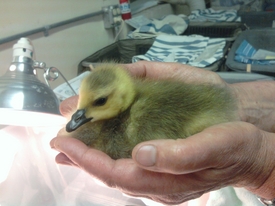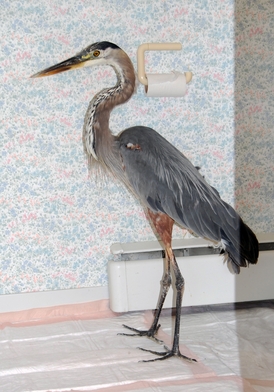Bird Center of Washtenaw County has become a vital resource for avian rehabilitation, seeks help in finding new location

A gosling
Flickr photo of Bird Center of Washtenaw County
When the doors open to the Bird Center of Washtenaw County on May 6, it will begin their eighth season, and it will runsuntil late August.
The organization has seen tremendous growth since their beginning; starting with just a handful of volunteers back in 2004 and now up to 90 — all serving the special needs of sick and injured wild avians in the area that are brought into their facility.
It's a unique cause to be involved in — unlike any other animal rescue. When a bird comes to the center for attention, the intention is for the creature to be released back into the wild to live on its own once it is able.
It's delicate, difficult work and isn't without its challenges. When dealing with birds — wild ones — there is a lot to take into consideration; the facility has to be ideal, as does the overall environment.
The organization has been leasing a city of Ann Arbor polling station on Mary Street during the spring and summer. During the last primary, the staff and volunteers needed to move everything out of the 700-square-foot facility so that polling could be held.
Ann Arbor Animal Hospital offered a room of their facility to house the birds during that period.

A heron, housed at the Bird Center for an injury
Photo courtesy of Bird Center of Washtenaw County
"Around 60 laundry baskets containing individual birds needed to be transported out, so you can imagine how daunting that was," says Phyllis Ponvert, a long-time volunteer and bird lover. "The transition was stressful for the birds."
A percentage of the avians that the organization cares for are baby birds, due to varying circumstances.
Ponvert continues, "For the baby birds especially, there has to be as little human interaction as possible."
That is a real challenge, as one needs to offer "hands-on" care, but try not to have actual physical contact: "Imprinting" the birds with a human presense jeopardizes their ability to function as the need to when they are re-introduced into the wild. Birds of like species serve as models to provide the proper imprinting for nestlings and juveniles, whenever possible.
Michigan has a plethora of wild birds, and the Bird Center sees many of them.
Carol Akerlof, executive director, gives some statistics from 2010.
"Last year, we answered over 2,017 logged phone calls for advice and help and admitted over 873 birds. We treat about 65 different species of birds each year."
These birds include nut hatches, Virginia rail and the Least Bittern, a marsh bird.
Because of the vast amount of species, it's important that the variety of food that they require is available — and it has to be fresh. Whether it be fresh fruit, ground chicken baby food, small live or dead fish, mealworms or other diets, it's a labor-intensive process. Baby birds, for example, need to be fed every 30 minutes from dawn until dusk.
Injured and sick birds benefit best from a quiet, stable environment to heal. To accommodate that requirement, voices are kept low, and the atmosphere is quiet.
Each bird's individual environment is fashioned out of laundry baskets lined with paper towels, the top overlaid with mesh and a cotton towel — almost cocoon-like. To suit small species and baby birds, clean yogurt containers and tissues are used instead.
The type of hands-on work done at the facility is so very different than that of other rescues, and the supplies used reflect that. Some of the unique tools used are flight cages — in order for birds to be assessed for their ability to function independently in the wild, they need to demonstrate their ability to fly in a safe environment. Bounty paper towels and Kleenex brand tissues are staple supplies always in need at the Bird Center.
Although grateful to have the current facility, there are challenges: lack of space required to prepare the bird's specific diets, the space not being ideal to sequester the intake and infirmary areas and it not being a dedicated space year-to-year.
For these reasons, the Bird Center needs to find a larger, permanent space. In doing so, they can better serve area avians, and their growth proves the need.
The Bird Center also works closely with the Humane Society of Huron Valley and has assisted Focus Wildlife staff in the clean up of the Marshall oil spill last year.
For those wondering why the focus on wild birds, it's simple.
"Birds are an important part of our eco-system," emphasizes Ponvert. "And, they're beautiful."
In essence, birds interacting with the flora in our ecosystems have a mutualistic relationship — that is, they both benefit from the relationship. While the bird gets food from the tree it visits, the tree benefits by having the bird carry out seed dispersal or pollination. Many trees cannot perform these processes without the help of our feathered friends.
Birds also eat insects — a lot of them.
To help offset the expenses of the upcoming season — and the sorely needed new facility — the Bird Center is holding a fundraiser, the Fly Away Benefit & Silent Auction on the evening of Saturday, April 30.
Silent Auction items include bird art from artists like Margaret Parker, Emil Weddige and Susan Falcone, as well as bird houses and feeders, a spotting scope, binoculars, baskets from Wild Birds Unlimited and the Wild Bird Center, a flight over Ann Arbor in a 1947 Cessna 140 piloted by a retired Air Force pilot, and more.
The benefit will be held at Weber's Inn in Ann Arbor and includes cocktails, hors d’oeuvres, a buffet dinner with three entree choices, dessert, and cash bar. Click here for ticket ordering information.
Ponvert indicates that one of the most common reasons that birds come to the facility are, you guessed it — flying into windows. But she offers some words of mindfulness with regard to keeping wild birds safe:
- When driving this time of year, use care and patience. Ducks commonly walk across busy streets, and either walk in pairs (a male and a female), or a female with her ducklings.
- Birds like chimney swifts like to nest in chimneys. If you hear unfamiliar noises coming from your fireplace, you might want to hold off using it until your unexpected tenants decide to leave.
For more information on the Bird Center of Washtenaw County and how to determine if a baby bird has been orphaned or is a fledgling, click here.
Lorrie Shaw is lead pets blogger for AnnArbor.com and owner of Professional Pet Sitting. Shoot her an email or contact her at 734-904-7279.


Comments
Lorrie Shaw
Thu, Apr 28, 2011 : 11:24 a.m.
godsbreath64: Glad that you enjoyed it. So thankful that this resource is here!
godsbreath64
Tue, Apr 26, 2011 : 8:24 p.m.
I've been in to see this wonderful work. Great job bringing this story to us. Thank you.